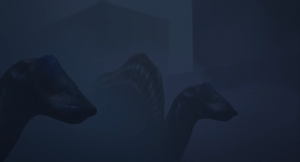
Ouranosaurus is a genus of Herbivorous dinosaur that lived in the Early Cretaceous period. The type specimen is known as Ouranosaurus Nigeriensis, and it lived from between 125 to 113 million years ago, in what is now present day Niger. It’s name comes from the Arabic for ‘Courage’, with the second part indicating the country of discovery.
Description:
Ouranosaurus was approximately 23 feet in length, and weight about 4.4 tons on average. This defines it as being rather large for an Iguanadontid. These animals also possess the most elongated skull of any non-hadrosaurid, as well.
The most notable feature of the Ouranosaurus is the large sail on its back, similar to that possessed by the Spinosaurus. This sail extended all the way from just above the forelegs, and terminated near the tail. The function of this sail is unknown, with some scientists speculating that they could have been used for thermoregulation of the animal.
Ouranosaurs were bred for the Jurassic World theme park on Isla Nublar. At least two specimens were cloned, although it is unknown as to what paddock they were housed in. It is possible due to their semi-aquatic nature though, that they could have been housed in Cretaceous Cruise.
Interactions with Humans:
A pair of Ouranosaurs encountered a stranded group of children at the Northwest dock of Jurassic World, sometime six months after the incident. They were strangely agitated, having torn down a fence to access the area, and very aggressive towards the children. One even attempted to attack a full grown Ankylosaurus, not being deterred from its pursuit of the humans. They would also attempt to attack the yacht as the children fled the attack, only being scared off by fireworks.

